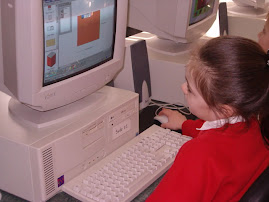

Introduction
Many people associate virtual reality and computer simulations with science fiction, high-tech industries, and computer games; few associate these technologies with education. But virtual reality and computer simulations have been in use as educational tools for some time. Although they have mainly been used in applied fields such as aviation and medical imaging, these technologies have begun to edge their way into the primary classroom. There is now a sizeable research base addressing the effectiveness of virtual reality and computer simulations within school curriculum. The following five sections present a definition of these technologies, a sampling of different types and their curriculum applications, a discussion of the research evidence for their effectiveness, useful Web resources, and a list of referenced research articles.
Definition and Types
Computer simulations are computer-generated versions of real-world objects (for example, a sky scraper or chemical molecules) or processes (for example, population growth or biological decay). They may be presented in 2-dimensional, text-driven formats, or, increasingly, 3-dimensional, multimedia formats. Computer simulations can take many different forms, ranging from computer renderings of 3-dimensional geometric shapes to highly interactive, computerized laboratory experiments.
Virtual reality is a technology that allows students to explore and manipulate computer-generated, 3-dimensional, multimedia environments in real time. There are two main types of virtual reality environments. Desktop virtual reality environments are presented on an ordinary computer screen and are usually explored by keyboard, mouse, wand, joystick, or touch screen. Web-based "virtual tours" are an example of a commonly available desktop virtual reality format. Total immersion virtual reality environments are presented on multiple, room-size screens or through a stereoscopic, head-mounted display unit. Additional specialized equipment such as a Data Glove (worn as one would a regular glove) enables the participant to interact with the virtual environment through normal body movements. Sensors on the head unit and Data Glove track the viewer's movements during exploration and provide feedback that is used to revise the display enabling real-time, fluid interactivity. Examples of virtual reality environments are a virtual solar system that enables users to fly through space and observe objects from any angle, a virtual science experiment that simulates the growth of microorganisms under different conditions, a virtual tour of an archeological site, and a recreation of the Constitutional Convention of 1787.
Applications across Curriculum Areas
Computer simulations and virtual reality offer students the unique opportunity of experiencing and exploring a broad range of environments, objects, and phenomena within the walls of the classroom. Students can observe and manipulate normally inaccessible objects, variables, and processes in real-time. The ability of these technologies to make what is abstract and intangible concrete and manipulability suits them to the study of natural phenomena and abstract concepts, "(VR) bridges the gap between the concrete world of nature and the abstract world of concepts and models (Yair, Mintz, & Litvak, 2001, p.294)." This makes them a welcome alternative to the conventional study of science and mathematics, which require students to develop understandings based on textual descriptions and 2-D representations.
The concretizing of objects atoms, molecules, and bacteria, for example, makes learning more straightforward and intuitive for many students and supports a constructivist approach to learning. Students can learn by doing rather than, for example, reading. They can also test theories by developing alternative realities. This greatly facilitates the mastery of difficult concepts, for example the relation between distance, motion, and time (Yair et al.).
It is not therefore surprising that math and science applications are the most frequent to be found in the research literature. Twenty-two of the thirty-one studies surveyed in this review of the literature investigated applications in science; 6 studies investigated math applications. In contrast, only one study investigated applications in the humanities curriculum (specifically, history and reading). The two remaining addressed generalized skills independent of a curriculum area.
It is important to keep in mind, however, when reading this review that virtual reality and computer simulations offer benefits that could potentially extend across the entire curriculum. For example, the ability to situate students in environments and contexts unavailable within the classroom could be beneficial in social studies, foreign language and culture, and English curricula, enabling students to immerse themselves in historical or fictional events and foreign cultures and explore them first hand. With regard to language learning, Schwienhorst (2002) notes numerous benefits of virtual reality, including the allowance of greater self-awareness, support for interaction, and the enabling of real-time collaboration (systems can be constructed to allow individuals in remote locations to interact in a virtual environment at the same time) (Schwienhorst, 2002).
The ability of virtual reality and computer simulations to scaffold student learning (Jiang & Potter, 1994; Kelly, 1997-98), potentially in an individualized way, is another characteristic that well suits them to a range of curriculum areas. An illustrative example of the scaffolding possibilities is a simulation program that records data and translates between notation systems for the student, so that he or she can concentrate on the targeted skills of learning probability (Jiang & Potter, 1994). The ability for students to revisit aspects of the environment repeatedly also helps put students in control of their learning.
The multi sensory nature can be especially helpful to students who are less visual learners and those who are better at comprehending symbols than text. With virtual environments, students can encounter abstract concepts directly, without the barrier of language or symbols and computer simulations and virtual environments are highly engaging, "There is simply no other way to engage students as virtual reality can (Sykes & Reid, 1999, p.61)." Thus, although math and science are the most frequently researched applications of these two technologies, humanities applications clearly merit the same consideration.
Evidence for Effectiveness
In the following sections, we discuss the evidence for the effectiveness of virtual reality and computer simulations based on an extensive survey of the literature published between 1980 and 2002. This survey included 31 research studies conducted in K-12 education settings and published in peer-reviewed journals (N=27) or presented at conferences (N=3) (it was necessary to include conference papers due to the low number of virtual reality articles in peer-reviewed journals). Every attempt was made to be fully inclusive but some studies could not be accessed in a timely fashion. Although the research base is somewhat small, particularly in the case of virtual reality, it provides some useful insights.
Virtual Reality
Numerous commentaries and/or descriptions of virtual reality projects in education have been published. Research studies are still relatively rare. We identified only 3 research investigations of virtual reality in the K-12 classroom: one journal article (Ainge, 1996) and two conference papers (Song, Han, & Yul Lee, 2000; Taylor, 1997).
Taylor's (1997) research was directed at identifying variables that influence students' enjoyment of virtual reality environments. After visiting a virtual reality environment, the 2,872 student participants (elementary, middle, and high school) rated the experience by questionnaire. Their responses were indicative of high levels of enjoyment throughout most of the sample. However, responses also indicated the need for further development of the interface both to improve students' ability to see in the environment and to reduce disorientation. Both factors were correlated with ratings of the environment's presence or authenticity, which itself was tightly associated with enjoyment. It's uncertain whether these technical issues remain a concern with today's virtual reality environments, which have certainly evolved since the time this study was published.
Whether or not virtual reality technology has yet been optimized to promote student enjoyment, it appears to have the potential to favorably impact the course of student learning. Ainge (1996) and Song et al. both provide evidence that virtual reality experiences can offer an advantage over more traditional instructional experiences at least within certain contexts. Ainge showed that students who built and explored 3D solids with a desktop virtual reality program developed the ability to recognize 3D shapes in everyday contexts, whereas peers who constructed 3D solids out of paper did not. Moreover, students working with the virtual reality program were more enthusiastic during the course of the study (which was, however, brief - 4 sessions). Song et al. reported that middle school students who spent part of their geometry class time exploring 3-D solids were significantly more successful at solving geometry problems that required visualization than were peers taught geometry by verbal explanation. Both studies, however, seem to indicate that the benefits of virtual reality experiences are often limited to very specific skills. For example, students taught by a VR approach were not any more effective at solving geometry problems that did not require visualization (Song et al.).
Clearly, the benefits of virtual reality experiences need to be defined in a more comprehensive way. For example, although numerous authors have documented student enjoyment of virtual reality (Ainge, 1996; Bricken & Byrne, 1992; Johnson, Moher, Choo, Lin, & Kim, 2002; Song et al.), it is still unclear whether virtual reality can offer more than transient appeal for students. Also, the contexts in which it can be an effective curriculum enhancement are still undefined. In spite of the positive findings reported here, at this point it would be premature to make any broad or emphatic recommendations regarding the use of virtual reality as a curriculum enhancement.
Computer Simulations
There is substantial research reporting computer simulations to be an effective approach for improving students' learning. Three main learning outcomes have been addressed: conceptual change, skill development, and content area knowledge.
Conceptual change.
One of the most interesting curriculum applications of computer simulations is the generation of conceptual change. Students often hold strong misconceptions be they historical, mathematical, grammatical, or scientific. Computer simulations have been investigated as a means to help students confront and correct these misconceptions, which often involve essential learning concepts. For example, Zietsman & Hewson (1986) investigated the impact of a microcomputer simulation on students' misconceptions about the relationship between velocity and distance, fundamental concepts in physics. Conceptual change in the science domain has been the primary target for these investigations, although we identified one study situated within the mathematics curriculum (Jiang & Potter, 1994). All 3 studies that we directly reviewed (Jiang & Potter, 1994; Kangassalo, 1994; Zietsman & Hewson, 1986) supported the potential of computer simulations to help accomplish needed conceptual change. Stratford (1997) discusses additional evidence of this kind (Brna, 1987; Gorsky & Finegold, 1992) in his review of computer-based model research in precollege science classrooms (Stratford, 1997).
The quality of this research is, however, somewhat uneven. Lack of quantitative data (Brna, 1987; Jiang & Potter, 1994; Kangassalo, 1994) and control group(s) (Brna, 1987; Gorsky & Finegold, 1992; Jiang & Potter, 1994; Kangassalo, 1994) are recurrent problems. Nevertheless, there is a great deal of corroboration in this literature that computer simulations have considerable potential in helping students develop richer and more accurate conceptual models in science and mathematics.
Skill development.
A more widely investigated outcome measure in the computer simulation literature is skill development. Of 12 studies, 11 reported that the use of computer simulations promoted skill development of one kind or another. The majority of these simulations involved mathematical or scientific scenarios (for example, a simulation of chemical molecules and a simulation of dice and spinner probability experiments), but a few incorporated other topic areas such as history (a digital text that simulated historical events and permitted students to make decisions that influenced outcomes) and creativity (a simulation of Lego block building). Skills reported to be improved include reading (Willing, 1988), problem solving (Jiang & Potter, 1994; Rivers & Vockell, 1987), science process skills (e.g. measurement, data interpretation, etc.; (Geban, Askar, & Ozkan, 1992; Huppert, Lomask, & Lazarowitz, 2002), 3D visualization (Barnea & Dori, 1999), mineral identification (Kelly, 1997-98), abstract thinking (Berlin & White, 1986), creativity (Michael, 2001), and algebra skills involving the ability to relate equations and real-life situations (Verzoni, 1995).
Seven (Barnea & Dori, 1999; Berlin & White, 1986; Huppert et al.; Kelly, 1997-98; Michael, 2001; Rivers & Vockell, 1987) of these twelve studies incorporated control groups enabling comparison of the effectiveness of computer simulations to other instructional approaches. Generally, they compared simulated explorations, manipulations, and/or experiments to hands-on versions involving concrete materials. The results of all 7 studies suggest that computer simulations can be implemented to as good or better effect than existing approaches.
There are interpretive questions, however, that undercut some of these studies' findings. One of the more problematic issues is that some computer simulation interventions have incorporated instructional elements or supports (Barnea & Dori, 1999; Geban et al.; Kelly, 1997-98; Rivers & Vockell, 1987; Vasu & Tyler, 1997) that are not present in the control treatment intervention. This makes it more difficult to attribute any advantage of the experimental treatment to the computer simulation per say. Other design issues such as failure to randomize group assignment (Barnea & Dori, 1999; Kelly, 1997-98; Rivers & Vockell, 1987; Vasu & Tyler, 1997; Verzoni, 1995) none of these studies specified that they used random assignment) and the use of ill-documented, qualitative observations (Jiang & Potter, 1994; Mintz, 1993; Willing, 1988) weaken some of the studies. When several of these flaws are present in the same study (Barnea & Dori, 1999; Kelly, 1997-98; Rivers & Vockell, 1987; Vasu & Tyler, 1997), the findings should be weighted more lightly. Even excluding such studies, however, the evidence in support of computer simulations still outweighs that against them.
Two studies reported no effect of computer simulation use on skill development (Mintz, 1993, hypothesis testing; Vasu & Tyler, 1997, problem solving). However, neither of these studies is particularly strong. Mintz (1993) presented results from a small sample of subjects and based conclusions on only qualitative, observational data. Vasu & Tyler (1997) provide no detailed information about the nature of the simulation program investigated in their study or how students interacted with it, making it difficult to evaluate their findings.
Thus, as a whole, there is good support for the ability of computer simulations to improve various skills, particularly science and mathematics skills. Important questions do remain. One of the more important questions future studies should address is the degree to which two factors, computer simulations' novelty and training for involved teachers and staff, are fundamental to realizing the benefits of this technology.
Content area knowledge.
Another potential curriculum application for computer simulations is the development of content area knowledge. According to the research literature, computer programs simulating topics as far ranging as frog dissection, a lake's food chain, microorganismal growth, and chemical molecules, can be effectively used to develop knowledge in relevant areas of the curriculum. Eleven studies in our survey investigated the impact of working with a computer simulation on content area knowledge. All 11 researched applications for the science curriculum, targeting, for example, knowledge of frog anatomy and morphology, thermodynamics, chemical structure and bonding, volume displacement, and health and disease. Students who worked with computer simulations significantly improved their performance on content-area tests (Akpan & Andre, 2000; Barnea & Dori, 1999; Geban et al.; Yildiz & Atkins, 1996). Working with computer simulations was in nearly every case as effective (Choi & Gennaro, 1987; Sherwood & Hasselbring, 1985/86) or more effective (Akpan & Andre, 2000; Barnea & Dori, 1999; Geban et al.; Huppert et al.; Lewis, Stern, & Linn, 1993; Woodward, Carnine, & Gersten, 1988) than traditional, hands-on materials for developing content knowledge.
Only two studies (Bourque & Carlson, 1987; Kinzer, Sherwood, & Loofbourrow, 1989) report an inferior outcome relative to traditional learning methods. Both studies failed to include a pretest, without which it is difficult to interpret posttest scores. Students in the simulation groups may have had lower posttest scores and still have made greater gains over the course of the experiment because they started out with less knowledge. Or they may have had more knowledge than their peers, resulting in a ceiling effect. Moreover, Bourque & Carlson (1997) designed their experiment in a way that may have confounded the computer simulation itself with other experimental variables. Students who worked off the computer took part in activities that were not parallel to those experienced by students working with computer simulations. Only students in the hands-on group were engaged in a follow-up tutorial and post-lab problem solving exercise.
Experimental flaws such as these are also problematic for many of the 11 studies that support the benefits of using computer simulations. Neither Choi & Gennaro (1987), Sherwood and Hasselbring (1985/86), nor Woodward et al. included a pretest. Like Bourque & Carlson (1997, above) both Akpan & Andre (2000) and Barnea & Dori (1999) introduced confounding experimental variables by involving the computer simulation group in additional learning activities (filling out a keyword and definition worksheet and completing a self study, review and quiz booklet, respectively). In addition, four studies (Barnea & Dori, 1999; Huppert et al.; Woodward et al.; Yildiz & Atkins, 1996) did not clearly indicate that they randomized assignment, and two did not include a control group (Lewis et al.; Yildiz & Atkins, 1996).
Little of the evidence to support computer simulations' promotion of content knowledge is iron clad. Although further study is important to repeat these findings, the quality of evidence is nevertheless on par with that supporting the use of traditional approaches. Taking this perspective, there is reasonably good support for the practice of using computer simulations as a supplement to or in place of traditional approaches for teaching content knowledge. However, the same questions mentioned above in talking about the skill development literature, linger here and need to be addressed in future research.
Factors Influencing Effectiveness
Factors influencing the effectiveness of computer simulations have not been extensively or systematically examined. Below we identify a number of likely candidates, and describe whatever preliminary evidence exists for their influence on successful learning outcomes.
Grade Level
At this point, it appears that computer simulations can be effectively implemented across a broad range of grade levels. Successful learning outcomes have been demonstrated for elementary (Berlin & White, 1986; Jiang & Potter, 1994; Kangassalo, 1994; Kinzer et al.; Park, 1993; Sherwood & Hasselbring, 1985/86; Vasu & Tyler, 1997; Willing, 1988), junior high (Akpan & Andre, 2000; Choi & Gennaro, 1987; Jackson, 1997; Jiang & Potter, 1994; Lewis et al.; Michael, 2001; Roberts & Blakeslee, 1996; Verzoni, 1995; Willing, 1988) and high school students (Barnea & Dori, 1999; Bourque & Carlson, 1987; Geban et al.; Huppert et al.; Jiang & Potter, 1994; Kelly, 1997-98; Mintz, 1993; Rivers & Vockell, 1987; Ronen & Eliahu, 1999; Willing, 1988; Woodward et al.; Yildiz & Atkins, 1996; Zietsman & Hewson, 1986). Because the majority of studies (14/27) have targeted junior high and high school populations, there is weightier support for these grade levels. But although fewer in numbers studies targeting students in grades 4 through 6 are also generally supportive of the benefits of using computer simulations. At this point, the early grades, 1-3 (Kangassalo, 1994) are too poorly represented in the research base to draw any conclusions about success of implementation.
Only one study has directly examined the impact of grade level on the effectiveness of using computer simulations. Berlin & White (1986) found no significant difference in the effectiveness of this approach for 2nd and 4th grade students. In the absence of other direct comparisons, a metaanalysis of existing research to determine the average effect size for different grade levels would help to determine whether this is a strong determinant of the effectiveness of computer simulations.
Student Characteristics
Looking across students, even just those considered to represent the "middle" of the distribution, there are considerable differences in their strengths, weaknesses, and preferences (Rose & Meyer, 2002). Characteristics at both the group and individual level have the potential to influence the impact of any learning approach. Educational group, prior experience, gender, and a whole variety of highly specific traits such as intrinsic motivation and cognitive operational stage are just a few examples. Although attention to such factors has been patchy at best, there is preliminary evidence to suggest that some of these characteristics may influence the success of using computer simulations.
With respect to educational group, the overwhelming majority of research studies have sampled subjects in the general population, making it difficult to determine whether educational group in any way influences the effectiveness of computer simulations. Only two studies (Willing, 1988; Woodward et al.) specifically mention the presence of students with special needs in their sample. Neither study gets directly at the question of whether educational group influences the effectiveness of computer simulations. However, they do make some interesting and important observations. Willing (1988) describes her sample of 222 students as being comprised mostly of students whom were considered average but in addition special education students, students with learning disabilities, and students who were gifted. Although Willing does not thoroughly address educational group in her presentation and analysis of the results, she does share a comment by one of the teachers that even less able readers seemed at ease reading when using the interactive historical text. Findings from Woodward et al. suggest not only that computer simulations can be effective for students with learning disabilities but that they may help to normalize these students' performance to that of more average-performing peers. Students with learning disabilities who worked with a computer simulation outperformed students without learning disabilities who did not receive any treatment. In contrast, untreated students without learning disabilities outperformed students without learning disabilities who took part in a control intervention consisting of conventional, teacher-driven activities.
Like educational group, gender is a factor sometimes associated with disparate achievement, particularly in math and science subject areas. In relation to the impact of computer simulations, however, it does not appear to be an important factor. Four studies in our review (Barnea & Dori, 1999; Berlin & White, 1986; Choi & Gennaro, 1987; Huppert et al.) directly examined the influence of gender on the outcome of working with computer simulations, and none demonstrated any robust relationship. In fact, a study by Choi & Gennaro (1987) suggests that when gender gaps in achievement exist, they persist during the use of computer simulations.
In contrast, there is evidence, although at this point isolated, that prior achievement can strongly influence the effectiveness of computer simulations. Yildiz & Atkins (1996) examined how prior achievement in science influences the outcome of working with different types of multimedia computer simulations. Students' prior achievement clearly affected the calculated effect size but how so depended on the type of computer simulation. These findings raise the possibility of very complex interactions between prior achievement and the type of computer simulation being used. They suggest that both factors may be essential for teachers to consider when weighing the potential benefits of implementing computer simulations.
Huppert et al. investigated whether students' cognitive stage might influence how much they profit from working with a computer simulation. Working with a computer simulation of microorganism growth differentially affected students' development of content understanding and science process skill depending on their cognitive stage. Interestingly, those with the highest cognitive stage (formative) experienced little improvement from working with the simulation, whereas students at the concrete or transitional operational stages notably improved. Thus, reasoning ability may be another factor influencing the usefulness of a computer simulation to a particular student.
There are many more potentially important variables that have rarely been considered or even described in research studies. For example, only a small number of studies have specified whether subjects are experienced (Choi & Gennaro, 1987; Yildiz & Atkins, 1996) or not (Bourque & Carlson, 1987) with using computers in the classroom. None have directly examined this variable's impact. More thoroughly describing the characteristics of sample populations would be an important first step toward sorting out such potentially important factors.
Teacher Training and Support
Given the unevenness of teachers' technology preparedness, training and support in using computer simulations seems like a potentially key factor in the effectiveness of using computer simulations in the classroom. As it the case with many of the other variables we've mentioned, few studies have described with much clarity or detail the nature of teacher training and support. Exceptions are Rivers & Vockell (1987) and Vasu & Tyler (1997), both of whom give quite thorough descriptions of staff development and available resources. This is another area that merits further investigation.
Instructional Context
It has been suggested that combining computer simulation work with hands-on work may produce a better learning outcome than either method alone. Findings from Bourque & Carlson (1997) support this idea. They found that students performed best when they engaged in hands-on experimentation followed by computer simulation activities. However, Akpan & Andre (2000) report that students learned as much doing the simulated dissection as they did doing both the simulated and real dissection. This is an interesting question but one that will require additional research to squarely address.
Links to Learn More about Virtual Reality & Computer Simulations
Virtual Reality Society
http://www.vrs.org.uk/VR/reference/history.html
The Virtual Reality Society (VRS), founded in 1994 is an international group dedicated to the discussion and advancement of virtual reality and synthetic environments. Its activities include the publication of an international journal, the organization of special interest groups, conferences, seminars and tutorials. This web site contains a rich history of article listings and publications on Virtual Reality.
Virtual Reality and Education Laboratory
www.soe.ecu.edu/
This is the homepage of Virtual Reality and Education Laboratory at East Carolina University in Greenville, North Carolina. The Virtual Reality and Education Laboratory (VREL) was created in 1992 to research virtual reality (VR) and its applications to the K-12 curriculum. Many projects are being conducted through VREL by researchers Veronica Pantelidis and Dr. Lawrence Auld. This web site provides links to VR in the Schools, an internationally referred journal distributed via the Internet. There are additional links to some VR sites recommended by these authors as exemplars and interesting sites.
Virtual Reality Resources for K-12 Education
http://archive.ncsa.uiuc.edu/people/bievenue/VR/
The NCSA Education & Outreach Group has compiled this web site containing links to multiple sites containing information and educational materials on Virtual Reality for Kindergarten through 12 grade classrooms.
Virtual Reality in Education: Learning in Virtual Reality
http://archive.ncsa.uiuc.edu/Edu/RSE/VR/
In collaboration with the National Center for Supercomputing Applications, the University of Illinois at Urbana-Champaign has created a five-year program to examine virtual reality (VR) in the classroom. One of the goals behind this program is to discover how well students can generalize their VR learning experiences outside of the classroom. This web site provides an explanation of the project with links to additional resources and Projects.
Human Interface Technology Laboratory, Washington Technology Center in Seattle
www.hitl.washington.edu/projects/knowledge_base/edvr/
This web site is the home of the Human Interface Technology Laboratory of the Washington Technology Center in Seattle, Washington. Various Virtual Reality (VR) articles and books are referenced. In addition to the list of articles and books, the technology center provides a list of internet resources including organizations that are doing research on VR, VR simulation environments and projects about various aspects of virtual reality.
Applied Computer Simulation Lab, Oregon Research Institute
www.ori.org/educationvr.html
This web site is from the Oregon Research Institute. The researchers at the Applied Computer Simulation Lab have created virtual reality (VR) programs that help physically disabled children operate motorized wheelchairs successfully. This website connects the reader to articles and information about these VR projects. Another project that this team is working on involves creating virtual reality programs for deaf blind students to help them "learn orientation and mobility skills in three dimensional acoustical spaces."
Strangman, N., & Hall, T. (2003). Virtual reality/simulations. Wakefield, MA: National Center on Accessing the General Curriculum. Retrieved12th October, 2007 from http://www.cast.org/publications/ncac/ncac_vr.html





































_JPG.jpg)
_JPG.jpg)
_JPG.jpg)
_JPG.jpg)
_JPG.jpg)

No comments:
Post a Comment